Home Fire Safety
Carbon Monoxide Alarm Information
 Is your family at risk for carbon monoxide poisoning? County Fire can provide you with information about carbon monoxide alarms, the risks of Carbon Monoxide poisoning and how it can be prevented.
Is your family at risk for carbon monoxide poisoning? County Fire can provide you with information about carbon monoxide alarms, the risks of Carbon Monoxide poisoning and how it can be prevented.
Facts
- According to the Center for Disease Control (CDC), over 400 unintentional deaths are related to carbon monoxide (CO) poisoning each year in the United States. CO is the leading cause of accidental poisoning deaths. (CDC, 2013)
- An estimated 20,000 people nationwide are treated annually for CO poisoning, but it is believed that many more are misdiagnosed or never seek medical care. (CDC, 2013)
- California law requires new and existing homes to install carbon monoxide alarms. (California Building Code Section 420, 2013)
Symptoms
- Early exposure to CO mimics flu-like symptoms; headaches, nausea, vomiting, dizziness, confusion, shortness of breath and fast heart rate.
 Sources
Sources
- CO is a toxic gas that is odorless, tasteless and invisible. CO is produced when fossil fuels burn incompletely due to insufficient oxygen. Fuels include natural gas, propane, kerosene, gasoline, coal, wood and charcoal.
- Sources of CO include the furnace, water heater, gas kitchen range or cooktop, gas clothes dryer, fireplace, space heater, portable generator, charcoal grill, wood-burning stove or an idling vehicle in an attached garage.
Causes
- Improper installation or poor maintenance of appliances. Automobile exhaust.
- Inadequate ventilation of appliances, including fuel burning space heaters and portable generators.
- Energy efficient homes that have added insulation, sealed windows and other weatherproofing can become ‘airtight’ and trap CO inside.
If CO poisoning is suspected, open windows and doors for fresh air. Leave the home and call 9-1-1 immediately.
CO Exposure
 Age, overall health, length of exposure and the concentration of the exposure (measured in parts per million) all determine the degree to which CO affects a person.
Age, overall health, length of exposure and the concentration of the exposure (measured in parts per million) all determine the degree to which CO affects a person.
A source of carbon monoxide poisoning, such as a faulty furnace, kitchen range or water heater can produce up to 1600 ppm. A charcoal grill 3200 ppm and tailpipe exhaust can easily produce in excess of 70,000 ppm. The table below shows typical symptoms based on concentration and time of exposure.
Concentration & Time of Exposure – Parts per million (ppm)
- 9 ppm EPA residential standard – not to exceed 9 ppm in 8 hours.
- 35 ppm EPA residential standard – not to exceed 35 ppm in 1 hour.
- 50 ppm OSHA workplace standard – not to exceed 50 ppm in an 8 hour period.
- 200 ppm Slight headache, fatigue, dizziness, nausea after 2-3 hours.
- 400 ppm Frontal headaches within 1-2 hours.Life threatening after 3 hours.
- 800 ppm Dizziness, nausea and convulsions within 45 minutes. Unconsciousness with 2 hours. Death within 2-3 hours.
- 1600 ppm Headache, dizziness and nausea within 20 minutes.Death within 1 hour.
- 12,800 ppm Death within 1-3 minutes.
Carbon monoxide alarms are designed to activate before potentially life-threatening levels of CO are reached. To reduce nuisance alarms, there are also requirements that each alarm must meet before it activates. (UL standard 2034)
Underwriters Laboratories (UL) Standards for CO Alarms @ 85 decibels
- 30 ppm present – Alarm will sound when present for more than 30 days.
(Alarm required to ignore low levels of CO unless present long-term.) - 70 ppm present – Alarm will sound within 1-4 hours.(Alarm required to ignore levels of 70 ppm for at least 1 hour before sounding.)
- 150 ppm present – Alarm will sound within 10-50 minutes.
- 400 ppm present – Alarm will sound within 4-15 minutes.
For more information about carbon monoxide poisoning and prevention tips:
Centers for Disease Control (Fact Sheets available in multi-languages)
CO Poisoning Prevention Guidelines (available in multi-languages)
Consumer Product Safety Commission
Environmental Protection Agency (EPA)
Federal Emergency Management Agency (FEMA)
National Fire Protection Association (NFPA)
Consumer Information:
Consumer Reports
Safewise Reviews
Escape Ladders
The easiest way out of your home is not always the safest way out during a fire.
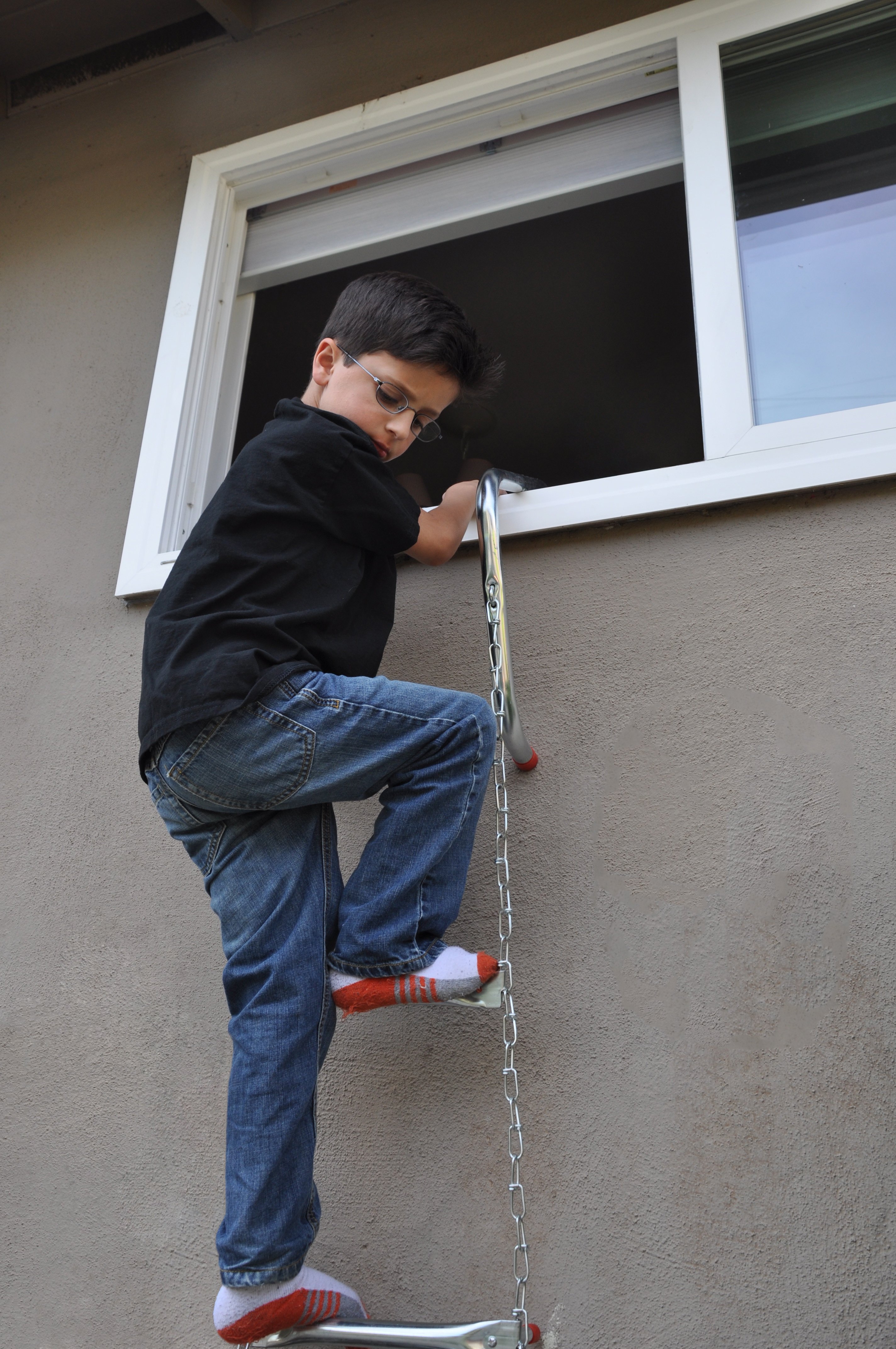 Portable fire escape ladders will provide an alternate escape route from second or third story windows. The National Fire Protection Association (NFPA), recommends one ladder in every occupied room on floors above the main level. Escape ladders are available for purchase through retailers, including hardware and major department stores.
Portable fire escape ladders will provide an alternate escape route from second or third story windows. The National Fire Protection Association (NFPA), recommends one ladder in every occupied room on floors above the main level. Escape ladders are available for purchase through retailers, including hardware and major department stores.
Listed below are some suppliers that offer two-story and three-story home escape ladders that may be purchased on line:
Escape Planning
According to the National Fire Protection Association (NFPA), betwen 2013 – 2017, US fire departments responded to an estimated average of 354,400 home structure fires per year. These fires caused an annual average of 2,620 civilian deaths; 11,220 civilian fire injuries; and $6.9 billion in direct property damage. 2,560 civilian fire deaths.
Plan Ahead! 
If a fire breaks out in your home, you may have less than a couple minutes to get out safely once the smoke alarm sounds. Everyone needs to know what to do and where to go if there is a fire. The easiest way out of your home is not always the safest way out during a fire.
Basic Fire Escape Planning
- Pull together everyone in your household and make a plan. Walk through your home and inspect all possible exits and escape routes. Households with children should consider drawing a floor plan of your home, marking two ways out of each room, including windows and doors. Also, mark the location of each smoke alarm. For more information, visit NFPA How to Make a Home FIre Escape Plan.
- Install smoke alarms in every sleeping room, outside each sleeping area and on every level of the home. Test smoke alarms monthly using a broom handle to reach test buttons and replace batteries yearly.
When you change your clocks at Daylight Savings, change the batteries in your smoke and carbon monoxide alarms.  Choose an outside meeting place, such as, a neighbor’s house, a mailbox, stop sign, etc., in the front yard and a safe distance from the home where everyone can meet up after they have escaped. Make sure to mark this meeting place location on the escape plan.
Choose an outside meeting place, such as, a neighbor’s house, a mailbox, stop sign, etc., in the front yard and a safe distance from the home where everyone can meet up after they have escaped. Make sure to mark this meeting place location on the escape plan.- Check to make sure all doors and windows can be opened easily. If windows or doors in your home have security bars, make sure that the bars have emergency release devices inside so that they can be opened immediately in an emergency. Emergency release devices won’t compromise your security – but they will increase your chances of safely escaping a home fire.
- Is your house number clearly visible from the street? If not, paint it on the curb or install house numbers to ensure that responding emergency personnel can find your home.
- Make arrangements in your escape plan for family members that may have special needs, such as, infants, older adults, or family members with mobility limitations. Make sure that someone is assigned to assist them in the fire drill and in the event of an emergency.
- Use an escape ladder(s) to provide a way out from the second or third floor. See below for more information about escape ladders.
- Be fully prepared in the event of a real fire! When smoke alarms sound, get out immediately and stay out!
- Once you’re out, stay out! Under no circumstances should you ever go back into a burning building. If someone is missing, inform the dispatcher when you call 9-1-1. Firefighters have the skills and equipment to perform rescues.
Practicing Your Home Escape Plan
 Practice your home fire escape plan twice a year. Make the drill as realistic as possible, especially for young children. Practicing the plan should include every member of the household.
Practice your home fire escape plan twice a year. Make the drill as realistic as possible, especially for young children. Practicing the plan should include every member of the household.- It’s important to determine during the drill whether children and others can readily waken to the sound of the smoke alarm. If they fail to awaken, assign someone to wake them up as part of the drill and in a real emergency situation.
- If your home has two floors, every family member (including children) must be able to escape from the second floor rooms. Escape ladders should be placed in or near windows to provide an additional escape route. Practice setting up the ladder so you learn how to do it quickly and correctly.
 Store the ladder near the window or in an easily accessible location in the bedroom. There is no time to search for it during a fire.
Store the ladder near the window or in an easily accessible location in the bedroom. There is no time to search for it during a fire.
Review the manufacturer’s instructions carefully so you’ll be able to use a safety ladder in an emergency. Escape ladders are available for purchase through retailers, including hardware and major department stores. NFPA recommends one ladder in every occupied room on floors above the main level.- Choose the safest escape route – the one with the least amount of smoke and heat – but be prepared to escape under toxic smoke if necessary. When you do a fire drill, everyone in the family should practice crawling low under the smoke to exit.
- As you exit, close doors behind you to help slow the spread of fire and smoke, giving you more time to escape. In some cases, smoke or fire may prevent you from exiting. To prepare for an emergency like this, practice “sealing yourself in for safety” as part of your home fire escape plan.
- Close all doors between you and the fire.
- Use duct tape or towels to seal the door cracks and cover air vents to keep smoke from coming in.
- If possible, open windows so fresh air can get in.
- Call 9-1-1 to report your exact location.
- Signal for help! Wave a flashlight or clothing item/cloth at the window to let the fire department know where you are located.
Fire Extinguisher Information
When detected early, portable fire extinguishers can put out small fires saving lives and property. Watch the training video below to learn how to operate a portable fire extinguisher. If a fire spreads beyond a small area, do not attempt to extinguish the fire. Evacuate the area immediately and call 9-1-1.
How to Operate a Fire Extinguisher
- Fire Extinguisher Information Brochure
- Fire Extinguisher Training Quiz
- Home Fire Safety Inspection Checklist
To Recharge or Service Fire Extinguishers
To recharge or service fire extinguishers, visit the Yellow Pages online www.yellowpages.com or www.myyp.com and search for “fire extinguishers” and to locate instructor-led fire extinguisher training for a business or workplace, search for “safety consultants”. Companies that service fire extinguishers may also have fire extinguisher training programs available.
Proper Disposal of Fire Extinguishers
To properly dispose of fire extinguishers, visit Santa Clara County Household Hazardous Waste Program at www.hhw.org or call 408.299.7300.
To operate a fire extinguisher, remember the acronym P.A.S.S.
- Pull the pin. Hold the extinguisher with the nozzle pointing away from you and twist pin to break the plastic locking strap.
- Aim the extinguisher. Point or aim the extinguisher at the base of the fire.
- Squeeze the handle. Squeeze the handle to discharge the extinguisher.
- Sweep from side to side. Keep the extinguisher aimed at the base of the fire and sweep from side to side, pushing the fire away from you.
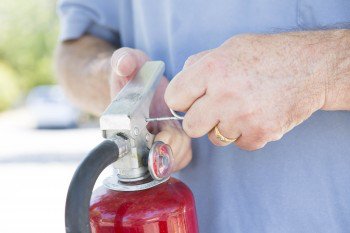 PULL the pin
PULL the pin
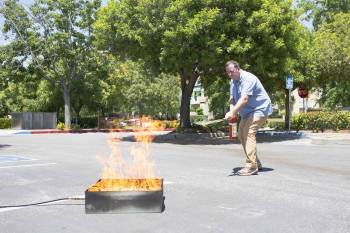 AIM the extinguisher at base of fire
AIM the extinguisher at base of fire
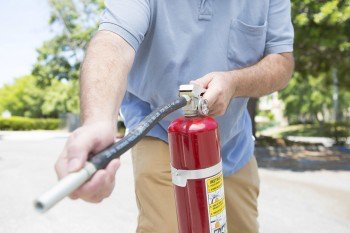 SQUEEZE the handle
SQUEEZE the handle
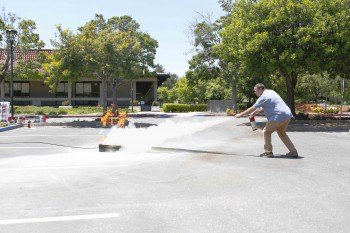 SWEEP from side to side
SWEEP from side to side
Safety Precautions
Keep in mind the following safety precautions if attempting to extinguish a small fire:
- Be sure you have the correct fire extinguisher for the type of fire and know how to use it.
- Maintain your exit. Leave yourself a way out in case the fire gets out of control.
- Have a back-up person standing by whenever possible in case assistance is needed.
- Stop and leave the area immediately if you experience any physical problems such as dizziness or difficulty breathing.
- Even if you think a fire is out, call the fire department to inspect the area. A fire may reignite or may still be smoldering where it cannot be seen.
Fire Sprinklers
Fire sprinklers save lives, reduce property loss and can even help cut homeowner insurance premiums.
Home fire sprinklers can contain and may even extinguish a fire in less time than it would take the fire department to arrive on the scene. In fact, just one activated sprinkler head contains or extinguishes 90% of all fires in homes with fire sprinkler systems!
Modern fire sprinklers provide unobtrusive protection and can be mounted flush with walls or ceilings. Advances in technology have allowed for some aesthetically pleasing changes to residential sprinklers and are now available in a wide variety of finishes and colors.
Nationally, on average, home fire sprinkler systems add 1% to 1.5% of the total building cost in new construction.
For more information about home fire sprinkler systems, visit the Home Fire Sprinkler Coalition website.
Heat Your Home Safely
Doing a simple, ten-minute check of a furnace can reduce the likelihood of serious danger from a malfunctioning system. Damaged or worn furnaces can emit lethal quantities of carbon monoxide, an odorless and colorless gas which can cause sickness or even death.
Ten Point Furnace Safety Check:
- Look for cracked, rusted, misaligned or clogged vents.
- Inspect for soot in the burning area and vents – this can be an indication that the gas burner is not properly adjusted and requires servicing.
- Clean all dust and lint near the burning chamber. Please ensure that the thermostat is in the off position prior to cleaning.
- Check your flue assembly for alignment and rigidity; a small earthquake is all it takes to loosen the flue to allow the products of combustion into your home.
- Make sure the flame is blue – a yellow flame may be a sign that the burner could be out of adjustment.
- Securely fasten the door that covers the pilot light and burner area.
- Do not store or use combustible materials or liquids near any gas appliance.
- Clean or replace your furnace filter and make sure the blower door is properly secured.
- Check ducts for leaks and have them properly insulated.
- Look for cracked or frayed blower belts.
The use of open fires indoors to stay warm and save money can be deadly because burning wood and charcoal also releases carbon monoxide.
Please take note of the following heating safety tips:
- Never use barbecues or charcoal inside your home, even in the fireplace.
- Never heat your home with a kerosene heater, gas range or other unvented appliances.
- Don’t burn treated or painted wood in your fireplace.
- Be sure to keep combustible materials such as bedding, clothing, draperies, rugs and furniture a safe distance from heating appliances. Remember to turn them off when you leave the room for an extended period.
- Damaged or poorly functioning natural gas equipment can not only waste money by leaking or burning gas inefficiently, but can also produce excess amounts of carbon monoxide if not adjusted properly.
For a FREE safety inspection, please call PG&E at 1(800) 743-5000.
Some of the appliances that PG&E inspects include:
- Furnaces
- Water heaters
- Gas fireplaces
- Ovens
- Ranges
- Hot tubs / pool heaters
- Clothes dryers
Additional helpful links:
Smoke Alarm Information
Each year in the United States almost 3,000 people are killed in home fires. Working smoke alarms increase your chances of surviving a fire by 50%. Smoke alarms are provided to residents based on economic need and/or installed based on a physical need.
What do I do?
- Purchase, install and maintain smoke alarms in your home.
- Develop and practice a home escape plan with your family.
 How Many and Where?
How Many and Where?
- For minimum protection, install smoke alarms in each bedroom, outside each sleeping area, such as the hallway, and on every level of your home.
- For maximum protection, install additional smoke alarms in each living area of your home.
Nuisance Alarms
If an alarm regularly responds to cooking smoke or shower steam, consider the following:
- Replace the alarm with one that has the silence button feature.
- Move the alarm further away to give cooking smoke or steam a chance to dissipate before reaching the unit.
- If ceiling mounted, move unit to a wall.
- If the unit is the ionization type, replace it with a photoelectric detector. This type of alarm is less sensitive to smaller particles and thus less affected by cooking smoke or small amounts of steam. Packaging and/or owner’s manual will indicate type of alarm.
Installation
 Mount smoke alarms in the middle of the ceiling, if possible.
Mount smoke alarms in the middle of the ceiling, if possible.- For wall-mounted units, place them at least 3′ (1 m) from any corner and 4-6″ (10-15cm) from the ceiling.
- Do not install smoke alarms near heating or cooling ducts.
- In mobile home units, install smoke alarms on inside walls.
Maintenance
- Test smoke alarms every month. For hard to reach units, use a broom handle or stick to press the test button.
- Replace batteries once a year. Use daylight savings time as your reminder. “Change your clocks… change your batteries.”
- If the low-battery signal begins to chirp, replace battery immediately.
- Vacuum the outside covers periodically to remove dust, dirt particles and insects.
Adaptive Smoke Alarms
For more information about adaptive smoke alarms for those with special needs, including talking, strobe (up to 177 candela), vibrating and amplified (up to 90 dB) smoke alarm products, please visit one of the following sites:
BRK Electronics
First Alert
Gentex
Kidde
MaxiAids

Be Safe…Replace!
Smoke alarms monitor the air 24 hours a day, every day. After 10 years, it’s been on the job for over 87,000 hours.For best protection, replace your smoke alarm units every 10 years.Failure Predictions
- First year: 2 – 3%
- Second to 10th year: 16 – 30%
- More than 10 years old: 30 – 50%
Do you remember when you installed your smoke alarms or how old they were when you moved in?
If you are not sure, it is best to just replace them!
FREE Smoke Alarm Installation:
If you live in one of the following cities or towns: Campbell, Cupertino, Los Altos, Los Altos Hills, Los Gatos, Monte Sereno, or Saratoga and you need assistance with your smoke or carbon monoxide alarms, please complete a Request a Program or Service form.
American Red Cross Northern California Coastal Home Fire Campaign
Consumer Information:
Consumer Reports
Safewise Reviews
Additional Resources & Information:
Home Fire Safety Inspection Checklist
NFPA Home Safety for People with Disabilities

